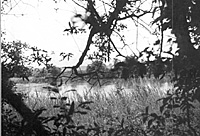At the beginning of 1815 the Brunswick Army was organised as follows:
CAVALRY
- Husaren-
Regiment
Uhlan squadron
INFANTRY
- Avantgarde
-
2 companies Celernte Jagers
2 companies Leichte(light) Infanterie
Leichte-Infanterie-Brigade
- Leib-Bataillon
1st Leichte-Bataillon
2nd Leichte-Bataillon
3rd Leichte-Bataillon
Linien-infanterie-Brigade
-
1st Linien-Infanterie-Bataillon
2nd Linien-Infanterie-Bataillon
3rd Linien-Infanterie-Bataillon
ARTILLERY
-
One foot battery-eight 9-pounder cannon
One horse battery-eight 6-pounder cannon
 The Materne pond and wood on the extreme left of the Allied position. This flank was successfully held by the 95th Rifles and the 2nd Leichte-Bataillon throughout the battle.
The Materne pond and wood on the extreme left of the Allied position. This flank was successfully held by the 95th Rifles and the 2nd Leichte-Bataillon throughout the battle.
The Hussar regiment had a staff of twenty, and six squadrons, each squadrons being composed of seven officers, eleven non-commissioned officers, four trumpeters and 101 Hussars.
The Uhlan squadron actually had two squadrons, each consisting of seven officers, thirteen NCOs, four trumpeters and 100 Uhlan. All the infantry battalions had exactly the same organisation. They each comprised four companies containing six officers, thirteen NCOs, thirteen drummers (or buglers in the Jager companies) and 150 men.
In addition, each battalion had a staff of ten. The horse artillery battery had ten officers, thirteen NCOs, four trumpeters and 145 gunners. The foot battery had fifteen officers, twelve NCOs, four drummers and 181 gunners.
There was also a ReserveInfanterie-Brigade which was a regionally-based militia:
- 1st(Braunshweig) Reserve-Infanterie-Bataillon
2nd (Wolfenbutte1) Reserve-Infanterie-Bataillon
3rd (Helmstedt) Reserve-Infanterie-Bataillon
4th (Harz) Reserve-Infanterie-Bataillon
5th (Wesser) Reserve-Infanterie-Bataillon
These battalions were organised along the same lines as the regular battalions. They did not take part in the Waterloo campaign. The other Brunswick forces formed an independent division of Wellington's Anglo-Allied army, commanded by Fredrich Wilhelm himself, who held the British rank of Lieutenant-General. It was agreed that the Duke would receive a subsidy from the British government based on the number of troops he placed in the field.
[3]
The Brunswick infantry and artillery
and a detachment of the Uhlan formed part of
Wellington's Reserve and they were quartered
in and around Brussels. The Hussars and the
remainder of the Uhlans were placed with the
main body of the Allied cavalry under the
command of the Earl of Uxbridge. They were
also posted in the vicinity of Brussels.
On the afternoon of 15 June, Wellington received
confirmation of Napoleon's advance into Belgium and he
ordered his Reserve to be ready to move at a moment's
notice. The Brunswick troops were instructed to assemble at
22:00 hours on the road between Brussels and Vilorder. Later
that evening Wellington was informed that the French had
attacked the Netherlands forces at Quatre Bras and the
Brunswickers were ordered to march immediately, the corps
leaving Brussels "Some time after 2 a.m." [4]
The Brunswick Corps at Quatre Bras
 Two linked photos showing almost the entire battlefield as viewed from the Namur road on the ground occupied by Peck's brigade of the 5th Division. On extreme right, the Charleroi road with what remains of the Bois de Bossu. Trees at right front surround the farm of Gemioncourt and those of the extreme left form part of the Materne wood which leads to the pond.
Two linked photos showing almost the entire battlefield as viewed from the Namur road on the ground occupied by Peck's brigade of the 5th Division. On extreme right, the Charleroi road with what remains of the Bois de Bossu. Trees at right front surround the farm of Gemioncourt and those of the extreme left form part of the Materne wood which leads to the pond.
Introduction and Background
Brunswick Army 1815
Battle of Quatre Bras
The Brunswick Memorial
Large Map of Quatre Bras Area (slow: 186K)
Brunswick Uniforms 1815 (slow: 104K)
Back to Table of Contents -- Age of Napoleon #32
Back to Age of Napoleon List of Issues
Back to MagWeb Master Magazine List
© Copyright 1999 by Partizan Press.
This article appears in MagWeb (Magazine Web) on the Internet World Wide Web. Other military history articles and gaming articles are available at http://www.magweb.com